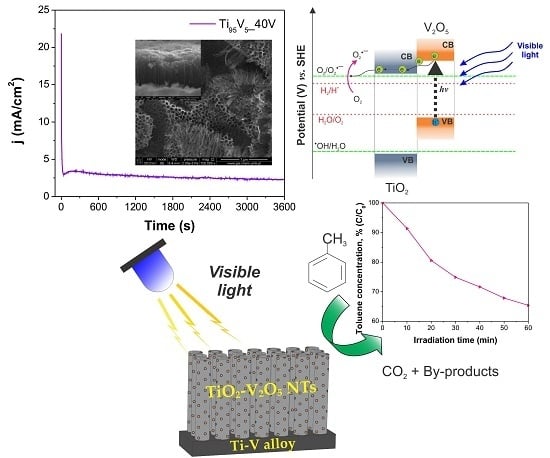Growth, Structure, and Photocatalytic Properties of Hierarchical V2O5–TiO2 Nanotube Arrays Obtained from the One-step Anodic Oxidation of Ti–V Alloys
Abstract
:1. Introduction
2. Results and Discussion
2.1. Morphology and Growth Mechanism
2.2. Optical Properties
2.3. Structural Properties
2.4. Photocatalytic Performance
3. Materials and Methods
3.1. Materials
3.2. Synthesis of Pristine TiO2 and V2O5-TiO2 Nanotubes
3.3. Characterization of Pristine TiO2 and V2O5-TiO2 Nanotubes
3.4. Measurement of Photocatalytic Activity
4. Conclusions
Acknowledgments
Author Contributions
Conflicts of Interest
References
- Ghicov, A.; Schmidt, B.; Kunze, J.; Schmuki, P. Photoresponse in the visible range from Cr doped TiO2 nanotubes. Chem. Phys. Lett. 2007, 433, 323–326. [Google Scholar] [CrossRef]
- Kubacka, A.; Fernandez-Garcia, M.; Colon, G. Advanced nanoarchitectures for solar photocatalytic applications. Chem. Rev. 2012, 112, 1555–1614. [Google Scholar] [CrossRef] [PubMed]
- Schneider, J.; Bahnemann, D.; Ye, J.; Puma, G.L.; Dionysiou, D.D. Photocatalysis: Fundamentals and Perspectives; Royal Society of Chemistry: Cambridge, UK, 2016. [Google Scholar]
- Dionysiou, D.D.; Puma, G.L.; Ye, J.; Schneider, J.; Bahnemann, D. Photocatalysis: Applications; Royal Society of Chemistry: Cambridge, UK, 2016. [Google Scholar]
- Pichat, P. Photocatalysis: Fundamentals, Materials and Potential; MDPI: Basel, Switzerland, 2016. [Google Scholar]
- Colmenares Quintero, J.C.; Xu, Y.-J. Heterogeneous Photocatalysis: From Fundamentals to Green Applications; Springer: Berlin/Heidelberg, Germany, 2016; Volume 8, p. 416. [Google Scholar]
- Fattakhova-Rohlfing, D.; Zaleska, A.; Bein, T. Three-dimensional titanium dioxide nanomaterials. Chem. Rev. 2014, 114, 9487–9558. [Google Scholar] [CrossRef] [PubMed]
- Daghrir, R.; Drogui, P.; Robert, D. Modified TiO2 for environmental photocatalytic applications: A review. Ind. Eng. Chem. Res. 2013, 52, 3581–3599. [Google Scholar] [CrossRef]
- Ahmed, S.; Rasul, M.G.; Brown, R.; Hashib, M.A. Influence of parameters on the heterogeneous photocatalytic degradation of pesticides and phenolic contaminants in wastewater: A short review. J. Environ. Manag. 2011, 92, 311–330. [Google Scholar] [CrossRef] [PubMed]
- Pichat, P. Photocatalysis and Water Purification: From Fundamentals to Recent Applications; John Wiley & Sons: Weinheim, Germany, 2013. [Google Scholar]
- Kang, D.; Kim, T.W.; Kubota, S.R.; Cardiel, A.C.; Cha, H.G.; Choi, K.S. Electrochemical synthesis of photoelectrodes and catalysts for use in solar water splitting. Chem. Rev. 2015, 115, 12839–12887. [Google Scholar] [CrossRef] [PubMed]
- Highfield, J. Advances and recent trends in heterogeneous photo(electro)-catalysis for solar fuels and chemicals. Molecules 2015, 20, 6739–6793. [Google Scholar] [CrossRef] [PubMed]
- Ye, M.; Zheng, D.; Wang, M.; Chen, C.; Liao, W.; Lin, C.; Lin, Z. Hierarchically structured microspheres for high-efficiency rutile TiO2-based dye-sensitized solar cells. ACS Appl. Mater. Interfaces 2014, 6, 2893–2901. [Google Scholar] [CrossRef] [PubMed]
- Low, J.; Cheng, B.; Yu, J. Surface modification and enhanced photocatalytic CO2 reduction performance of Tio2: A review. Appl. Surf. Sci. 2017, 392, 658–686. [Google Scholar] [CrossRef]
- Wang, R.; Hashimoto, K.; Fujishima, A.; Chikuni, M.; Kojima, E.; Kitamura, A.; Shimohigoshi, M.; Watanabe, T. Light-induced amphiphilic surfaces. Nature 1997, 388, 431–432. [Google Scholar] [CrossRef]
- Pichat, P. Self-cleaning materials based on solar photocatalysis. In New and Future Developments in Catalysis: Solar Photocatalysis; Suib, S.L., Ed.; Elsevier: Amsterdam, The Netherlands, 2013; Volume 7, pp. 167–190. [Google Scholar]
- Li, Z.; Luo, W.; Zhang, M.; Feng, J.; Zou, Z. Photoelectrochemical cells for solar hydrogen production: Current state of promising photoelectrodes, methods to improve their properties, and outlook. Energy Environ. Sci. 2013, 6, 347–370. [Google Scholar] [CrossRef]
- Pfitzner, A.; Dankesreiter, S.; Eisenhofer, A.; Cherevatskaya, M. Heterogeneous semiconductor photocatalysis. In Chemical Photocatalysis; König, B., Ed.; De Gruyter: Berlin, Germany, 2013. [Google Scholar]
- Skinner, D.E.; Colombo, D.P.; Cavaleri, J.J.; Bowman, R.M. Femtosecond investigation of electron trapping in semiconductor nanoclusters. J. Phys. Chem. 1995, 99, 7853–7856. [Google Scholar] [CrossRef]
- Banerjee, S.; Pillai, S.C.; Falaras, P.; O’Shea, K.E.; Byrne, J.A.; Dionysiou, D.D. New insights into the mechanism of visible light photocatalysis. J. Phys. Chem. Lett. 2014, 5, 2543–2554. [Google Scholar] [CrossRef] [PubMed]
- Wang, Z.; Ma, W.; Chen, C.; Zhao, J. Sensitization of titania semiconductor: A promising strategy to utilize visible light. In Photocatalysis and Water Purification; Pichat, P., Ed.; Wiley-VCH: Weinheim, Germany, 2013; pp. 199–240. [Google Scholar]
- Choi, W.; Termin, A.; Hoffmann, M.R. The role of metal ion dopants in quantum-sized TiO2: Correlation between photoreactivity and charge carrier recombination dynamics. J. Phys. Chem. 1994, 98, 13669–13679. [Google Scholar] [CrossRef]
- Asahi, R.; Morikawa, T.; Ohwaki, T.; Aoki, K.; Taga, Y. Visible-light photocatalysis in nitrogen-doped titanium oxides. Science 2001, 293, 269–271. [Google Scholar] [CrossRef] [PubMed]
- Li, D.; Haneda, H.; Labhsetwar, N.K.; Hishita, S.; Ohashi, N. Visible-light-driven photocatalysis on fluorine-doped TiO2 powders by the creation of surface oxygen vacancies. Chem. Phys. Lett. 2005, 401, 579–584. [Google Scholar] [CrossRef]
- Mazierski, P.; Nischk, M.; Gołkowska, M.; Lisowski, W.; Gazda, M.; Winiarski, M.J.; Klimczuk, T.; Zaleska-Medynska, A. Photocatalytic activity of nitrogen doped TiO2 nanotubes prepared by anodic oxidation: The effect of applied voltage, anodization time and amount of nitrogen dopant. Appl. Catal. B Environ. 2016, 196, 77–88. [Google Scholar] [CrossRef]
- Mazierski, P.; Lisowski, W.; Grzyb, T.; Winiarski, M.J.; Klimczuk, T.; Mikołajczyk, A.; Flisikowski, J.; Hirsch, A.; Kołakowska, A.; Puzyn, T.; et al. Enhanced photocatalytic properties of lanthanide-TiO2 nanotubes: An experimental and theoretical study. Appl. Catal. B Environ. 2017, 205, 376–385. [Google Scholar] [CrossRef]
- Chatterjee, D.; Mahata, A. Demineralization of organic pollutants on the dye modified TiO2 semiconductor particulate system using visible light. Appl. Catal. B Environ. 2001, 33, 119–125. [Google Scholar] [CrossRef]
- Hirai, T.; Suzuki, K.; Komasawa, I. Preparation and photocatalytic properties of composite CdS nanoparticles–titanium dioxide particles. J. Colloid Interface Sci. 2001, 244, 262–265. [Google Scholar] [CrossRef]
- Zielińska-Jurek, A.; Zaleska, A. Ag/Pt-modified TiO2 nanoparticles for toluene photooxidation in the gas phase. Catal. Today 2014, 230, 104–111. [Google Scholar] [CrossRef]
- Nischk, M.; Mazierski, P.; Wei, Z.; Siuzdak, K.; Kouame, N.A.; Kowalska, E.; Remita, H.; Zaleska-Medynska, A. Enhanced photocatalytic, electrochemical and photoelectrochemical properties of TiO2 nanotubes arrays modified with Cu, AgCu and Bi nanoparticles obtained via radiolytic reduction. Appl. Surf. Sci. 2016, 387, 89–102. [Google Scholar] [CrossRef] [PubMed]
- Pichat, P. Surface-properties, activity and selectivity of bifunctional powder photocatalysts. New J. Chem. 1987, 11, 135–140. [Google Scholar]
- Wu, Z.; Dong, F.; Liu, Y.; Wang, H. Enhancement of the visible light photocatalytic performance of C-doped TiO2 by loading with V2O5. Catal. Commun. 2009, 11, 82–86. [Google Scholar] [CrossRef]
- Wang, Y.; Zhang, J.; Liu, L.; Zhu, C.; Liu, X.; Su, Q. Visible light photocatalysis of V2O5/TiO2 nanoheterostructures prepared via electrospinning. Mater. Lett. 2012, 75, 95–98. [Google Scholar] [CrossRef]
- Yang, X.; Ma, F.; Li, K.; Guo, Y.; Hu, J.; Li, W.; Huo, M.; Guo, Y. Mixed phase titania nanocomposite codoped with metallic silver and vanadium oxide: New efficient photocatalyst for dye degradation. J. Hazard. Mater. 2010, 175, 429–438. [Google Scholar] [CrossRef] [PubMed]
- Wang, Y.; Su, Y.R.; Qiao, L.; Liu, L.X.; Su, Q.; Zhu, C.Q.; Liu, X.Q. Synthesis of one-dimensional TiO2/V2O5 branched heterostructures and their visible light photocatalytic activity towards rhodamine b. Nanotechnology 2011, 22, 225702. [Google Scholar] [CrossRef] [PubMed]
- Li, B.; Xu, Y.; Rong, G.; Jing, M.; Xie, Y. Vanadium pentoxide nanobelts and nanorolls: From controllable synthesis to investigation of their electrochemical properties and photocatalytic activities. Nanotechnology 2006, 17, 2560–2566. [Google Scholar] [CrossRef] [PubMed]
- Fei, H.-L.; Zhou, H.-J.; Wang, J.-G.; Sun, P.-C.; Ding, D.-T.; Chen, T.-H. Synthesis of hollow V2O5 microspheres and application to photocatalysis. Solid State Sci. 2008, 10, 1276–1284. [Google Scholar] [CrossRef]
- Shahid, M.; Rhen, D.S.; Shakir, I.; Patole, S.P.; Yoo, J.B.; Yang, S.-J.; Kang, D.J. Facile synthesis of single crystalline vanadium pentoxide nanowires and their photocatalytic behavior. Mater. Lett. 2010, 64, 2458–2461. [Google Scholar] [CrossRef]
- Qiu, G.; Dharmarathna, S.; Genuino, H.; Zhang, Y.; Huang, H.; Suib, S.L. Facile microwave-refluxing synthesis and catalytic properties of vanadium pentoxide nanomaterials. ACS Catal. 2011, 1, 1702–1709. [Google Scholar] [CrossRef]
- Shen, T.F.R.; Lai, M.-H.; Yang, T.C.K.; Fu, I.P.; Liang, N.-Y.; Chen, W.-T. Photocatalytic production of hydrogen by vanadium oxides under visible light irradiation. J. Taiwan Inst. Chem. Eng. 2012, 43, 95–101. [Google Scholar] [CrossRef]
- Aslam, M.; Ismail, I.M.; Salah, N.; Chandrasekaran, S.; Qamar, M.T.; Hameed, A. Evaluation of sunlight induced structural changes and their effect on the photocatalytic activity of V2O5 for the degradation of phenols. J. Hazard. Mater. 2015, 286, 127–135. [Google Scholar] [CrossRef] [PubMed]
- Xie, L.; Liu, P.; Zheng, Z.; Weng, S.; Huang, J. Morphology engineering of V2O5/TiO2 nanocomposites with enhanced visible light-driven photofunctions for arsenic removal. Appl. Catal. B Environ. 2016, 184, 347–354. [Google Scholar] [CrossRef]
- Choi, S.; Lee, M.-S.; Park, D.-W. Photocatalytic performance of TiO2/V2O5 nanocomposite powder prepared by DC arc plasma. Curr. Appl. Phys. 2014, 14, 433–438. [Google Scholar] [CrossRef]
- Zhu, K.; Neale, N.R.; Miedaner, A.; Frank, A.J. Enhanced charge-collection efficiencies and light scattering in dye-sensitized solar cells using oriented TiO2 nanotubes arrays. Nano Lett. 2007, 7, 69–74. [Google Scholar] [CrossRef] [PubMed]
- Lee, K.; Mazare, A.; Schmuki, P. One-dimensional titanium dioxide nanomaterials: Nanotubes. Chem. Rev. 2014, 114, 9385–9454. [Google Scholar] [CrossRef] [PubMed]
- Macak, J.M.; Schmuki, P. Anodic growth of self-organized anodic TiO2 nanotubes in viscous electrolytes. Electrochim. Acta 2006, 52, 1258–1264. [Google Scholar] [CrossRef]
- Pichat, P. Are TiO2 nanotubes worth using in photocatalytic purification of air and water? Molecules 2014, 19, 15075–15087. [Google Scholar] [CrossRef] [PubMed]
- Albu, S.P.; Ghicov, A.; Macak, J.M.; Schmuki, P. 250 µm long anodic TiO2 nanotubes with hexagonal self-ordering. Phys. Status Solidi–R. 2007, 1, R65–R67. [Google Scholar] [CrossRef]
- Khudhair, D.; Bhatti, A.; Li, Y.; Hamedani, H.A.; Garmestani, H.; Hodgson, P.; Nahavandi, S. Anodization parameters influencing the morphology and electrical properties of TiO2 nanotubes for living cell interfacing and investigations. Mater. Sci. Eng. C 2016, 59, 1125–1142. [Google Scholar] [CrossRef] [PubMed]
- Nischk, M.; Mazierski, P.; Gazda, M.; Zaleska, A. Ordered TiO2 nanotubes: The effect of preparation parameters on the photocatalytic activity in air purification process. Appl. Catal. B Environ. 2014, 144, 674–685. [Google Scholar] [CrossRef]
- Mazierski, P.; Nadolna, J.; Lisowski, W.; Winiarski, M.J.; Gazda, M.; Nischk, M.; Klimczuk, T.; Zaleska-Medynska, A. Effect of irradiation intensity and initial pollutant concentration on gas phase photocatalytic activity of TiO2 nanotube arrays. Catal. Today 2016, 284, 19–26. [Google Scholar] [CrossRef]
- Bashirom, N.; Razak, K.A.; Yew, C.K.; Lockman, Z. Effect of fluoride or chloride ions on the morphology of ZrO2 thin film grown in ethylene glycol electrolyte by anodization. Procedia Chem. 2016, 19, 611–618. [Google Scholar] [CrossRef]
- Tsuchiya, H.; Schmuki, P. Self-organized high aspect ratio porous hafnium oxide prepared by electrochemical anodization. Electrochem. Commun. 2005, 7, 49–52. [Google Scholar] [CrossRef]
- Jha, H.; Hahn, R.; Schmuki, P. Ultrafast oxide nanotube formation on TiNb, TiZr and TiTa alloys by rapid breakdown anodization. Electrochim. Acta 2010, 55, 8883–8887. [Google Scholar] [CrossRef]
- Yang, Y.; Kim, D.; Schmuki, P. Electrochromic properties of anodically grown mixed V2O5-TiO2 nanotubes. Electrochem. Commun. 2011, 13, 1021–1025. [Google Scholar] [CrossRef]
- Yang, Y.; Kim, D.; Yang, M.; Schmuki, P. Vertically aligned mixed V2O5-TiO2 nanotube arrays for supercapacitor applications. Chem. Commun. 2011, 47, 7746–7748. [Google Scholar] [CrossRef] [PubMed]
- Paramasivam, I.; Nah, Y.C.; Das, C.; Shrestha, N.K.; Schmuki, P. WO3/TiO2 nanotubes with strongly enhanced photocatalytic activity. Chemistry 2010, 16, 8993–8997. [Google Scholar] [CrossRef] [PubMed]
- Ning, X.; Wang, X.; Yu, X.; Li, J.; Zhao, J. Preparation and capacitance properties of Mn-doped TiO2 nanotube arrays by anodisation of Ti-Mn alloy. J. Alloys Compd. 2016, 658, 177–182. [Google Scholar] [CrossRef]
- Allam, N.K.; Deyab, N.M.; Abdel Ghany, N. Ternary Ti-Mo-Ni mixed oxide nanotube arrays as photoanode materials for efficient solar hydrogen production. Phys. Chem. Chem. Phys. 2013, 15, 12274–12282. [Google Scholar] [CrossRef] [PubMed]
- Luo, B.; Yang, H.; Liu, S.; Fu, W.; Sun, P.; Yuan, M.; Zhang, Y.; Liu, Z. Fabrication and characterization of self-organized mixed oxide nanotube arrays by electrochemical anodization of Ti-6Al-4V alloy. Mater. Lett. 2008, 62, 4512–4515. [Google Scholar] [CrossRef]
- Mazierski, P.; Malankowska, A.; Kobylański, M.; Diak, M.; Kozak, M.; Winiarski, M.J.; Klimczuk, T.; Lisowski, W.; Nowaczyk, G.; Zaleska-Medynska, A. Photocatalytically active TiO2/Ag2O nanotube arrays interlaced with silver nanoparticles obtained from the one-step anodic oxidation of Ti-Ag alloys. ACS Catal. 2017, 7, 2753–2764. [Google Scholar] [CrossRef]
- Ding, J.; Huang, Z.; Zhu, J.; Kou, S.; Zhang, X.; Yang, H. Low-temperature synthesis of high-ordered anatase TiO2 nanotube array films coated with exposed {001} nanofacets. Sci. Rep. 2015, 5, 17773. [Google Scholar] [CrossRef] [PubMed]
- Nevárez-Martínez, M.C.; Mazierski, P.; Kobylański, M.; Szczepańska, G.; Trykowski, G.; Malankowska, A.; Kozak, M.; Espinoza-Montero, P.J.; Zaleska-Medynska, A. Self-organized TiO2-MnO2 nanotube arrays for efficient photocatalytic degradation of toluene. Molecules 2017, 22, 564. [Google Scholar] [CrossRef] [PubMed]
- Macak, J.M.; Tsuchiya, H.; Ghicov, A.; Yasuda, K.; Hahn, R.; Bauer, S.; Schmuki, P. TiO2 nanotubes: Self-organized electrochemical formation, properties and applications. Curr. Opin. Solid State Mater. Sci. 2007, 11, 3–18. [Google Scholar] [CrossRef]
- Wood, G.C.; Khoo, S.W. The mechanism of anodic oxidation of alloys. J. Appl. Electrochem. 1971, 1, 189–206. [Google Scholar] [CrossRef]
- Cox, B. 186. Complex fluorides. Part IV. The structural chemistry of complex fluorides of the general formula ABF6. J. Chem. Soc. 1956, 876–878. [Google Scholar] [CrossRef]
- Wu, J.C.S.; Chen, C.-H. A visible-light response vanadium-doped titania nanocatalyst by sol-gel method. J. Photochem. Photobiol. A Chem. 2004, 163, 509–515. [Google Scholar] [CrossRef]
- Nishanthi, S.T.; Subramanian, E.; Sundarakannan, B.; Padiyan, D.P. An insight into the influence of morphology on the photoelectrochemical activity of TiO2 nanotube arrays. Sol. Energy Mater. Sol. Cell 2015, 132, 204–209. [Google Scholar] [CrossRef]
- Tang, H.; Berger, H.; Schmid, P.E.; Lévy, F. Optical properties of anatase (TiO2). Solid State Commun. 1994, 92, 267–271. [Google Scholar] [CrossRef]
- Knorr, F.J.; Mercado, C.C.; McHale, J.L. Trap-state distributions and carrier transport in pure and mixed-phase TiO2: Influence of contacting solvent and interphasial electron transfer. J. Phys. Chem. C 2008, 112, 12786–12794. [Google Scholar] [CrossRef]
- Chin, S.; Park, E.; Kim, M.; Jurng, J. Photocatalytic degradation of methylene blue with TiO2 nanoparticles prepared by a thermal decomposition process. Powder Technol. 2010, 201, 171–176. [Google Scholar] [CrossRef]
- Zhang, W.; He, Y.; Zhang, M.; Yin, Z.; Chen, Q. Raman scattering study on anatase TiO2 nanocrystals. J. Phys. D Appl. Phys. 2000, 33, 912. [Google Scholar] [CrossRef]
- Wu, Z.; Dong, F.; Zhao, W.; Wang, H.; Liu, Y.; Guan, B. The fabrication and characterization of novel carbon doped TiO2 nanotubes, nanowires and nanorods with high visible light photocatalytic activity. Nanotechnology 2009, 20, 235701. [Google Scholar] [CrossRef] [PubMed]
- Borbón-Nuñez, H.A.; Dominguez, D.; Muñoz-Muñoz, F.; Lopez, J.; Romo-Herrera, J.; Soto, G.; Tiznado, H. Fabrication of hollow TiO2 nanotubes through atomic layer deposition and MWCNT templates. Powder Technol. 2017, 308, 249–257. [Google Scholar] [CrossRef]
- Sethi, D.; Jada, N.; Tiwari, A.; Ramasamy, S.; Dash, T.; Pandey, S. Photocatalytic destruction of escherichia coli in water by V2O5/TiO2. J. Photochem. Photobiol. B 2015, 144, 68–74. [Google Scholar] [CrossRef] [PubMed]
- Ohsaka, T.; Izumi, F.; Fujiki, Y. Raman spectrum of anatase, TiO2. J. Raman Spectrosc. 1978, 7, 321–324. [Google Scholar] [CrossRef]
- Kim, Y.S.; Song, M.Y.; Park, E.S.; Chin, S.; Bae, G.N.; Jurng, J. Visible-light-induced bactericidal activity of vanadium-pentoxide (V2O5)-loaded TiO2 nanoparticles. Appl. Biochem. Biotechnol. 2012, 168, 1143–1152. [Google Scholar] [CrossRef] [PubMed]
Sample Availability: Samples of the compounds are available from the authors. |
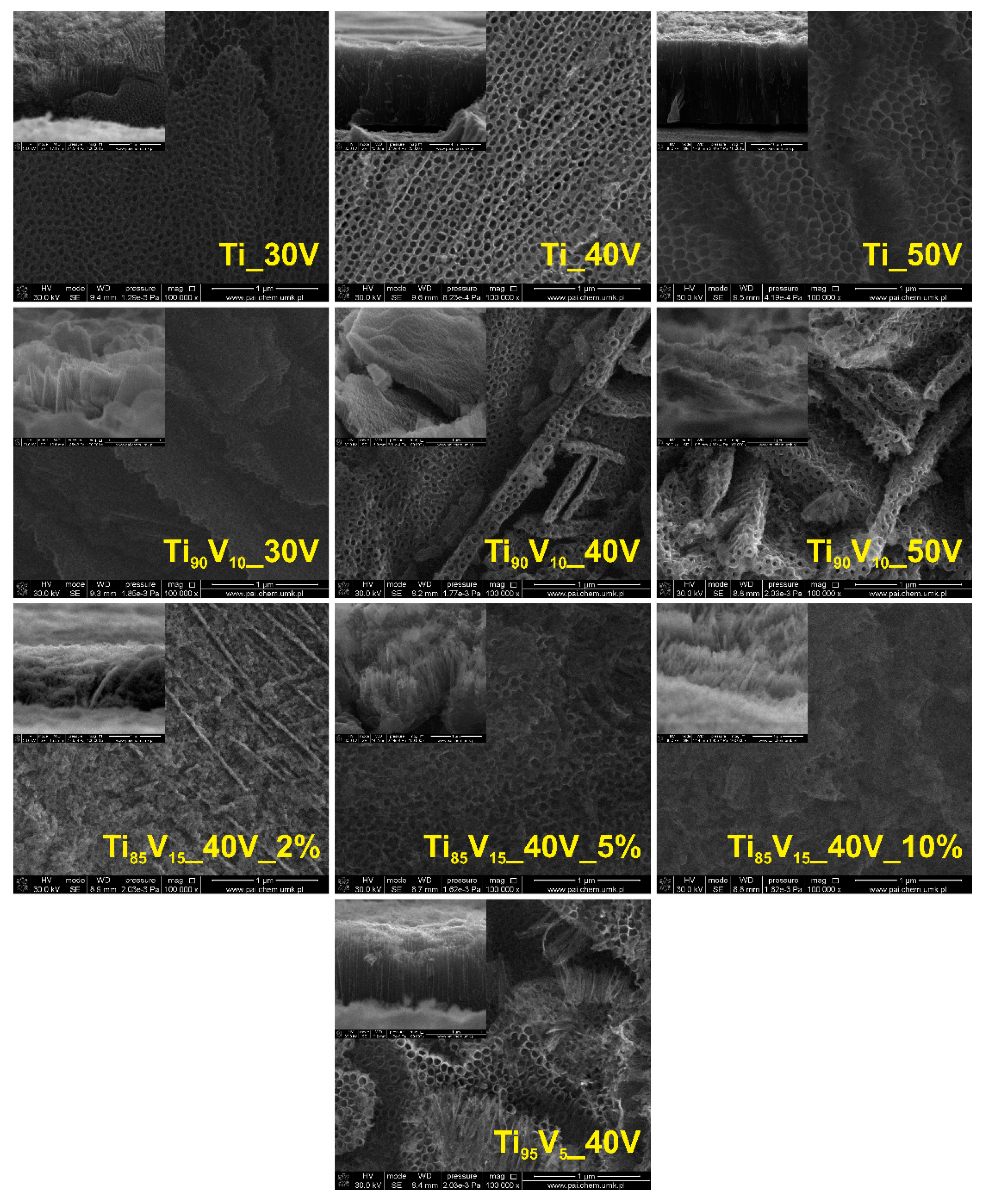

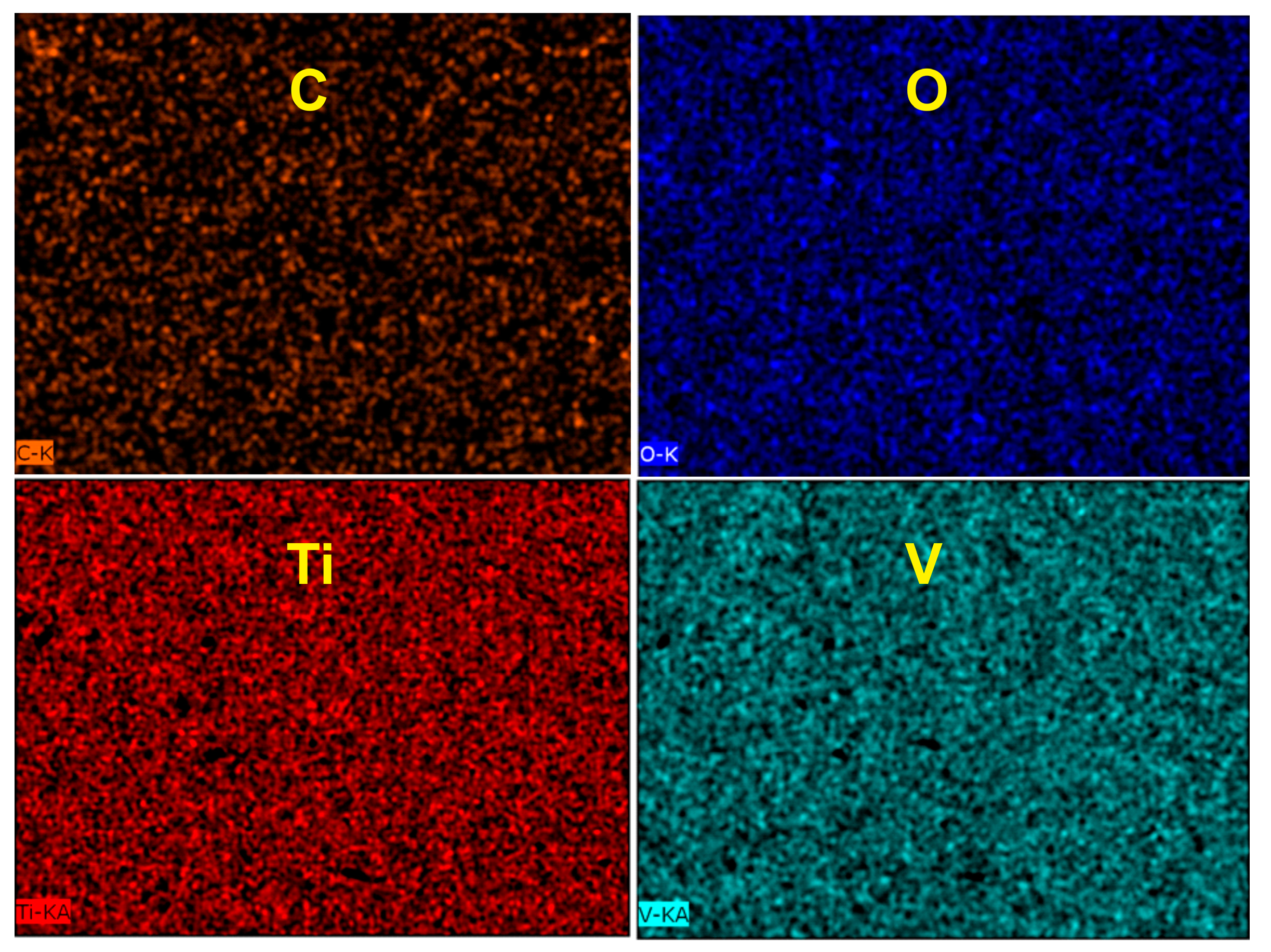


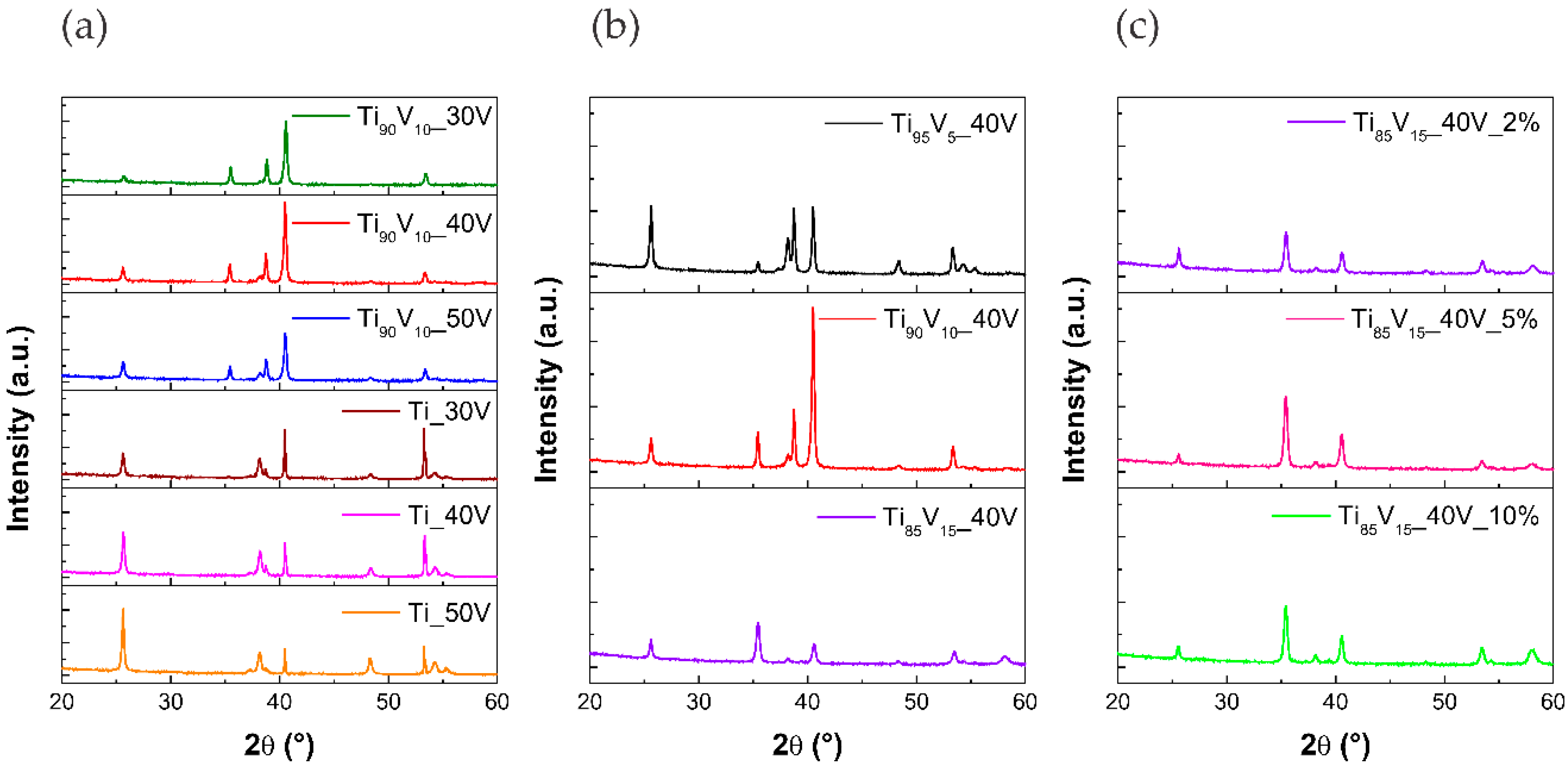


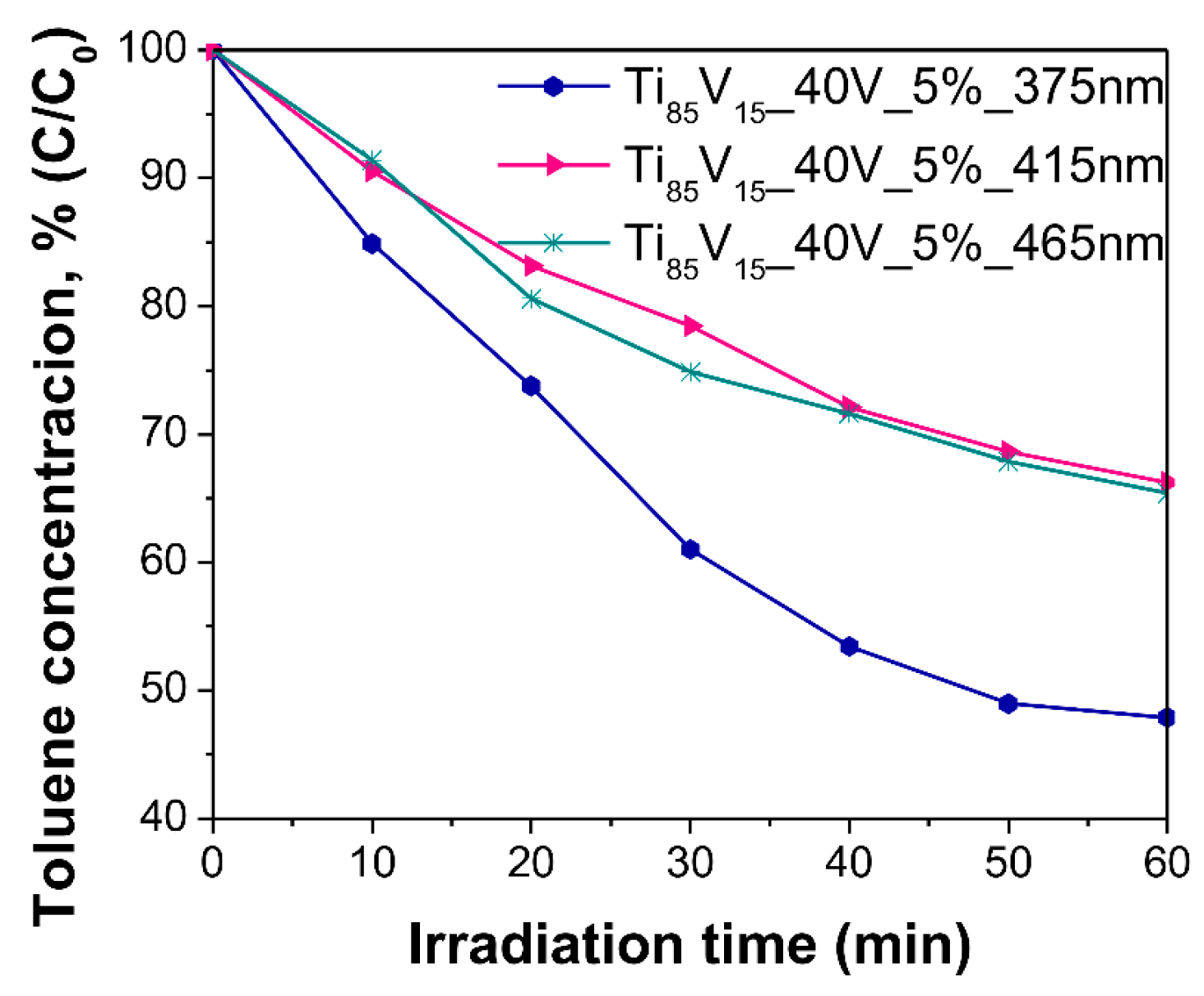
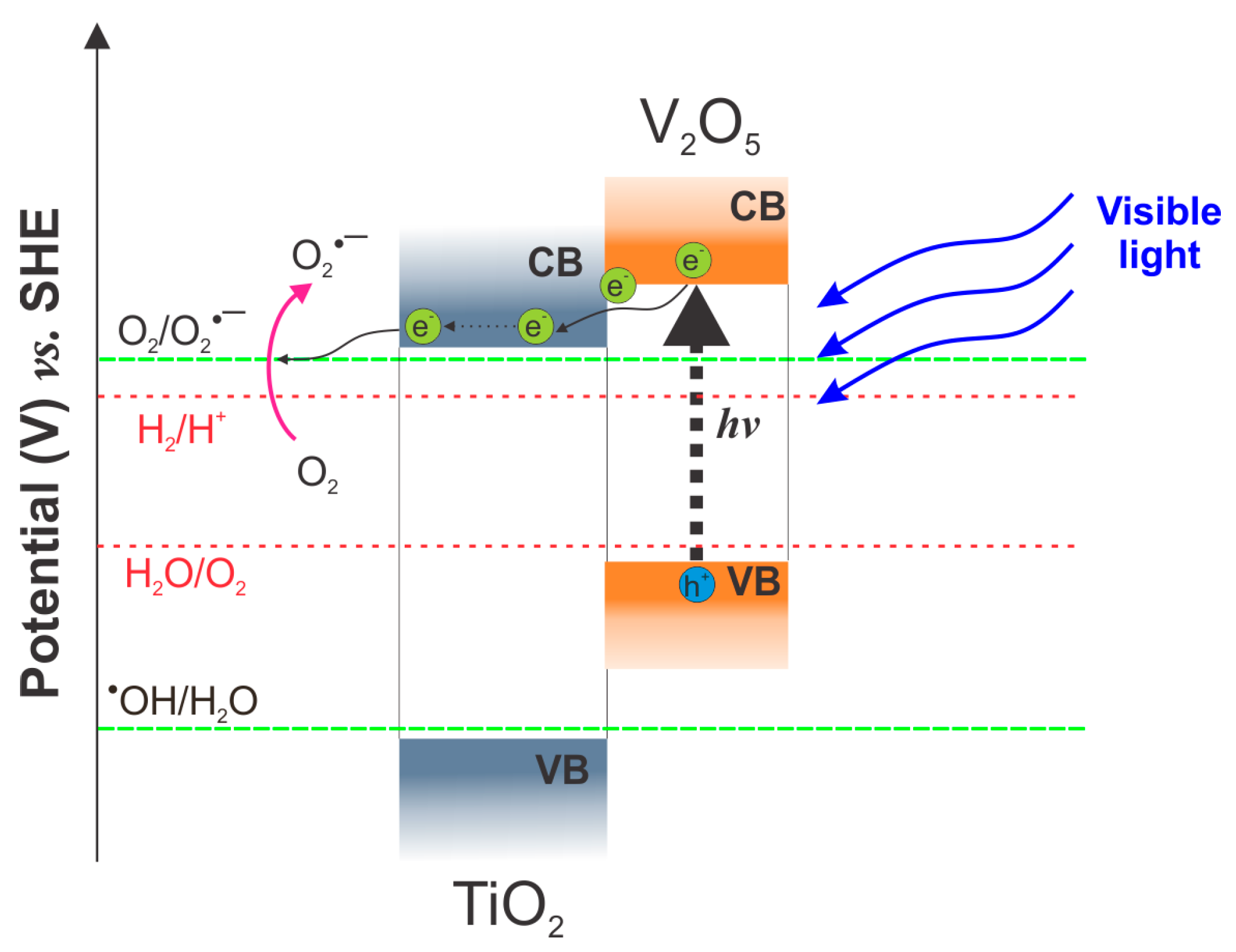
| Sample Label | Preparation Parameters | External Diameter (nm) | Tube Length (μm) | Wall Thickness (nm) | Average Crystallite Size (nm) | EDX Analysis | Photoactivity Vis Light (λmax = 465 nm) | |||||
|---|---|---|---|---|---|---|---|---|---|---|---|---|
| Electrolyte | Applied Potential (V) | Ti (wt %) | V (wt %) | C (wt %) | O (wt %) | Initial Reaction Rate × 102 (μmol·dm−3·min−1) | Reaction Rate Constant × 103 (min−1) | |||||
| Ti90V10_30V | EG 98% (v/v), H2O 2% (v/v), NH4F 0.09 M | 30 | 61 | 0.8 | 13 | 31 | 74.61 | 7.61 | 0.01 | 17.78 | 5.34 | 5.98 |
| Ti90V10_40V | EG 98% (v/v), H2O 2% (v/v), NH4F 0.09 M | 40 | 91 | 0.3 | 19 | 32 | 73.84 | 7.39 | 0.01 | 18.78 | 6.76 | 7.57 |
| Ti90V10_50V | EG 98% (v/v), H2O 2% (v/v), NH4F 0.09 M | 50 | 101 | 0.4 | 30 | 30 | 69.34 | 6.85 | 0.01 | 23.79 | 6.56 | 7.35 |
| Ti85V15_40V_2% | EG 98% (v/v), H2O 2% (v/v), NH4F 0.09 M | 40 | Sponge-like structure | 31 | 73.09 | 12.14 | 0.01 | 14.78 | 6.62 | 7.41 | ||
| Ti85V15_40V_5% | EG 95% (v/v), H2O 5% (v/v), NH4F 0.09 M | 40 | 103 | 0.9 | 20 | 36 | 67.06 | 9.08 | 1.10 | 22.77 | 7.08 | 7.92 |
| Ti85V15_40V_10% | EG 90% (v/v), H2O 10% (v/v), NH4F 0.09 M | 40 | Sponge-like structure | 32 | 66.10 | 8.91 | 1.14 | 23.86 | 4.50 | 5.04 | ||
| Ti95V5_40V | EG 98% (v/v), H2O 2% (v/v), NH4F 0.09 M | 40 | 86 | 1.0 | 11 | 33 | 72.59 | 3.25 | 0.02 | 24.14 | 5.39 | 6.04 |
| Ti_30V | EG 98% (v/v), H2O 2% (v/v), NH4F 0.09 M | 30 | 81 | 1.5 | 10 | 33 | 71.47 | 0.00 | 0.19 | 28.34 | 0.37 | 0.42 |
| Ti_40V | EG 98% (v/v), H2O 2% (v/v), NH4F 0.09 M | 40 | 100 | 5.0 | 13 | 34 | 66.73 | 0.00 | 0.03 | 33.24 | 0.43 | 0.49 |
| Ti_50V | EG 98% (v/v), H2O 2% (v/v), NH4F 0.09 M | 50 | 120 | 16.2 | 18 | 38 | 67.69 | 0.00 | 0.03 | 32.28 | 0.64 | 0.72 |
© 2017 by the authors. Licensee MDPI, Basel, Switzerland. This article is an open access article distributed under the terms and conditions of the Creative Commons Attribution (CC BY) license (http://creativecommons.org/licenses/by/4.0/).
Share and Cite
Nevárez-Martínez, M.C.; Mazierski, P.; Kobylański, M.P.; Szczepańska, G.; Trykowski, G.; Malankowska, A.; Kozak, M.; Espinoza-Montero, P.J.; Zaleska-Medynska, A. Growth, Structure, and Photocatalytic Properties of Hierarchical V2O5–TiO2 Nanotube Arrays Obtained from the One-step Anodic Oxidation of Ti–V Alloys. Molecules 2017, 22, 580. https://doi.org/10.3390/molecules22040580
Nevárez-Martínez MC, Mazierski P, Kobylański MP, Szczepańska G, Trykowski G, Malankowska A, Kozak M, Espinoza-Montero PJ, Zaleska-Medynska A. Growth, Structure, and Photocatalytic Properties of Hierarchical V2O5–TiO2 Nanotube Arrays Obtained from the One-step Anodic Oxidation of Ti–V Alloys. Molecules. 2017; 22(4):580. https://doi.org/10.3390/molecules22040580
Chicago/Turabian StyleNevárez-Martínez, María C., Paweł Mazierski, Marek P. Kobylański, Grażyna Szczepańska, Grzegorz Trykowski, Anna Malankowska, Magda Kozak, Patricio J. Espinoza-Montero, and Adriana Zaleska-Medynska. 2017. "Growth, Structure, and Photocatalytic Properties of Hierarchical V2O5–TiO2 Nanotube Arrays Obtained from the One-step Anodic Oxidation of Ti–V Alloys" Molecules 22, no. 4: 580. https://doi.org/10.3390/molecules22040580





